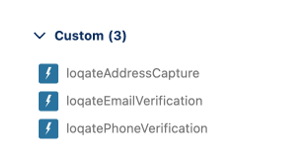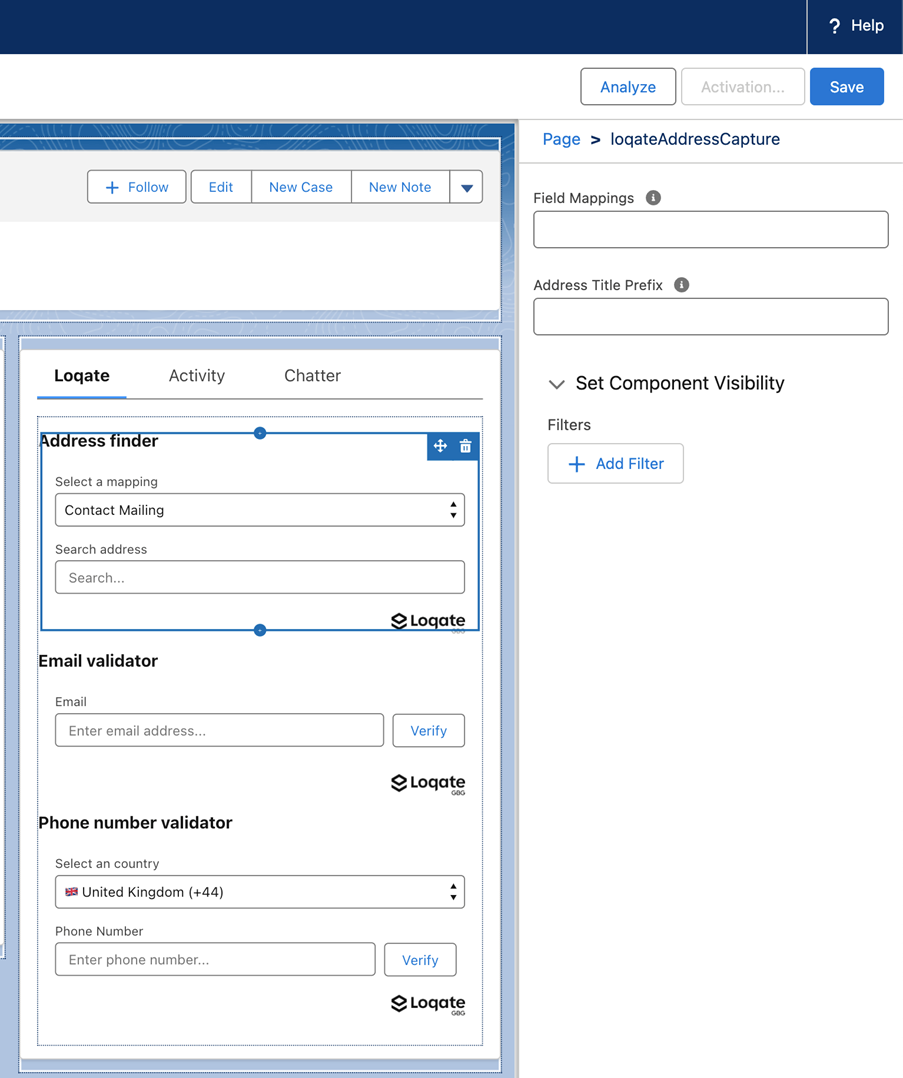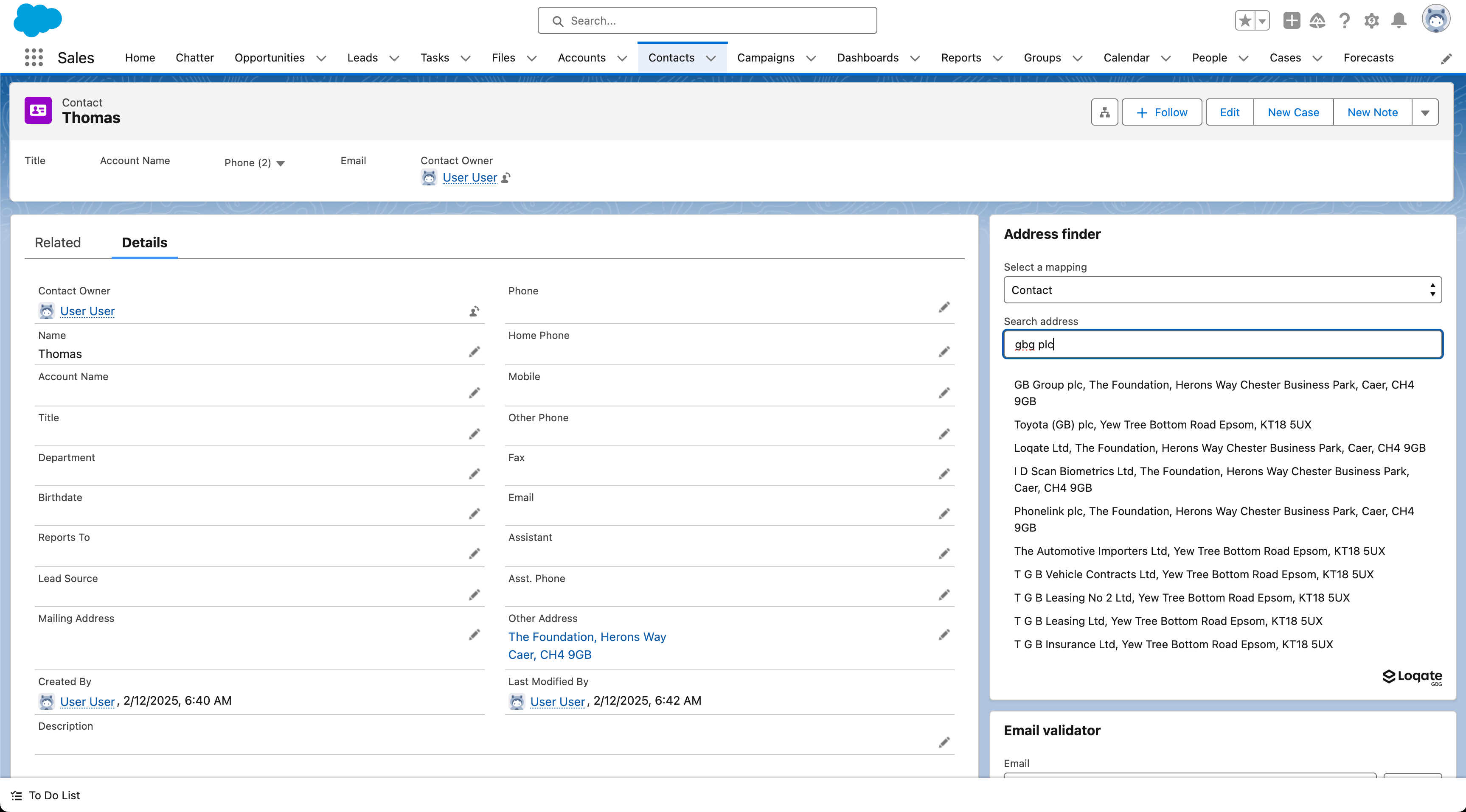The Loqate Salesforce CRM Integration Guide
Download from the Salesforce AppExchange
The Loqate app, available from the Salesforce AppExchange, allows you to quickly and easily add Loqate address verification services to your instance of Salesforce CRM, providing type-ahead lookup functionality for address fields, and validation for both email addresses and phone numbers. With some or all of these services enabled, you can reduce the amount of time spent inputting customer details, and improve the accuracy of your database.
Available services
The Loqate app gives you access to these Loqate services in your Salesforce CRM instance:
- Address Capture, which provides a type-ahead solution for address input - referred to in Salesforce as Address finder
- Email Validation, which ensures the accuracy of customer email addresses - referred to in Salesforce as Email validator
- Phone Validation, which ensures the accuracy of customer phone numbers - referred to in Salesforce as Phone number validator
Prerequisites
Before installing the Loqate app you will need:
- A live Salesforce CRM account
- A live Loqate account
- A Loqate API key*
*Note that your API key is designed to be an open access key to your account - there are security controls within your Loqate account to ensure this is not abused. The key used in the app will be your primary mechanism of reporting for usage, so we recommend create a new key rather than reusing one you may already have on a website or other application.
Process
There are a few quick steps to get the Loqate app up and running:
- Install the app
- Assign permissions
- Add your Loqate API key
- Set up address mappings
- Add Loqate widgets to your object pages
- Optional: Address finder settings
If you only want to use the Email validator and Phone validator controls, you can skip the address mapping step. If you want to also use the Address finder control though, please follow all of the steps below.
Installing the Loqate app
We recommend installing the Loqate app directly from the Salesforce AppExchange - adding the app from here will ensure you're always installing the latest version.
Setting permissions
The Loqate app includes two permission sets: Loqate Administrator and Loqate User. The use cases for these sets are as follows:
- Loqate User: for any users who need to use the Loqate controls on the page to validate addresses, email addresses and/or phone numbers, but don’t need to administer the settings of the app itself
- Loqate Administrator: for users who need to administer settings and mappings for the app, as well as use the controls as per the Loqate User permission set
Set the permissions as required for each of your users under Setup > Permission Sets, then move on to the next step.

App setup
With the app installed and permission sets assigned, the next step is to add your Loqate API key to the app, which you can do in the API Settings section of the Loqate Settings page.

Note: accessing the Settings page requires the Loqate Administrator permission set.
Select the Loqate app from the App Launcher, then copy and paste your API key into the API Settings section and click Save. With that done, the Email validator and Phone validator controls are both enabled and can be added to pages - if you only want to use those two controls, you can skip ahead to the Loqate widgets section. To add the Address finder control as well, follow the steps below for creating address mappings.
Address mappings
For each address type that you want to populate using the Address finder control, you need to create an address mapping. This may involve creating multiple mappings for a single object - for example, for the Contact object you might create one mapping for the 'Mailing' address and another for the 'Other' address.
You can create address mappings in the Settings page of the Loqate app.
- In the Mappings section, click New Mapping
- Name your mapping (we recommend using a distinct and memorable name, to distinguish it from other address types - for example, "Contact Mailing")
- From the 'Select an object' drop-down, choose the object that you want to create a mapping for

- Click the + Add Field button, then from the 'Select a field' drop-down choose a field that you want to populate with address data
- From the 'Select a element' drop-down, choose a Loqate element to map to your chosen field

- Click the Add Field Mapping button to save and add your new mapping to the list

You can create as many mappings as you need by just repeating these steps.
Custom mappings
If required, you can also use custom address mappings.
- When selecting an element to map to a field, choose the custom format option option from the drop-down list
- In the 'Custom pattern' field that appears, enter your custom field mapping
- For example, entering "{line1},{ line2} will concatenate line1 and line2, separated by a comma and a space (assuming line2 is available - if not, only line1 will be included)

- See the Formatting section of our Advanced Setup Guide for more information about custom field values
Loqate widgets
In order to start using Loqate functionality, you need to add each control (i.e. Address finder, Email validator and Phone validator, where appropriate) to your object pages.
- From the Details tab on the Contacts page, select Settings and then Edit Page

- In the Lightning App Builder, look for the Loqate controls in the Custom section of the Components menu. You should see loqateAddressCapture, loqateEmailVerification and loqatePhoneVerification:

- You can drag each of these onto your page, placing them where you want them. Here's an example showing all three components added to the right-hand side of the page:

- Once you've placed all of the components, Save and Activate the page to be able to start using them
- Repeat this process for all pages that you want to add the Loqate features to
Optional: Address finder settings
The Address finder control includes some additional settings which you can amend if required. To see these settings, select an Address finder control where it's been added to one of your pages.

You'll need to amend the settings for each instance of the control.
Field mappings
By default, the Address finder control will display a select box listing all of the mappings you've created for the object on which the control has been placed. You can then select the relevant mapping you want to use.
Optionally though, you can lock the Address finder control to a particular mapping by entering a specific mapping name in the Field Mappings box. The control will no longer display the 'Select a mapping' box, and will instead always use the mapping you've chosen.
Address title prefix
If you have multiple Address finder controls on a single page (for example if you've locked one or more of them to particular mappings), it's useful to give each one a specific name to clearly differentiate them. You can use this setting to add additional text to the start of each control's title.
Whatever text you enter in the Address Title Prefix box will be added at the start of its title - so for example if you have both 'mailing' and 'other' address fields on a page, add "Mailing" into this box for one of the controls so that it will display as "Mailing Address finder".
In use
With the Loqate app installed and configured, you can start using the Address finder, Email validator and Phone number validator controls when inputting addresses, email addresses and phone numbers into Salesforce.
For example, here's how the Address finder control looks during an address search:
